Toilet cuff: how to choose a suitable part and install it
The toilet is the main element of the toilet, without which this room cannot perform the functions assigned to it. For joining the above accessory of the sanitary room with the sewer network, there is a polymer or rubber cuff for the toilet bowl, which needs to be properly selected and installed.
The instruction below will help you to do it yourself.
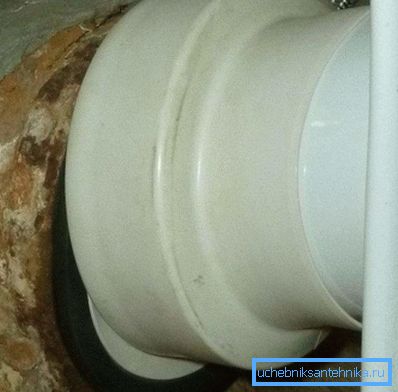
Product Description
Before we talk about how to put the cuff on the toilet, let's see what is this part and what purpose it performs. Externally, the product consists of two cylinders of different diameters, hermetically sealed to each other. If you look at the cuff in profile, you can see that the longitudinal axes of the two components either completely coincide or are offset relative to each other.
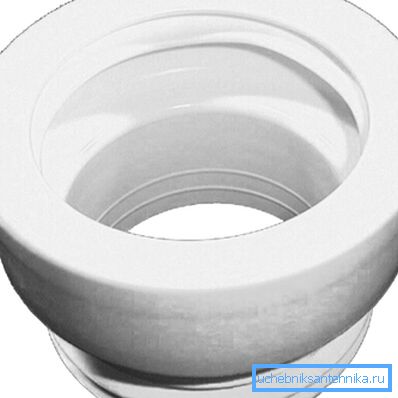
Most often, the part is made of plastic. The use of polymers allows you to create the most durable and reliable product that will hermetically connect the toilet outlet to the pipes. The integrity of the cuff is not violated over time (unless as a result of shock or other mechanical action).
The second advantage of the polymer is ease of processing. Plastic can take any form (you just need to pour it into the appropriate blank), so you can make cuffs of any, even the most unusual configuration, out of it.
Note! In addition to plastic, there are rubber cuffs to the toilet. They are used to connect the sanitary device with sewage pipes made of cast iron. Due to the low prevalence of the latter, rubber parts are currently rarely used.
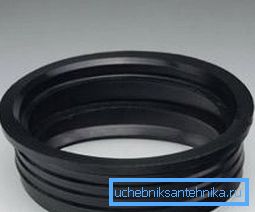
The main types of cuffs used in modern construction are shown in the table.
| View | Description |
| Eccentric | It has a direct shape and standard configuration. The axes of the two cylinders can be shifted relative to each other. The toilet cuff is suitable for the installation of conventional toilet bowls with direct or oblique release, without any special structural elements. The main purpose is to provide a reliable connection with pipes. The eccentric cuff copes with its task for 100%. |
| Corrugated | Used in cases where the straight cuff is not suitable for any reason. Often this happens in cases where the acquired toilet has a specific shape or sizes other than the standard. The corrugated cuff can bend at different angles, which makes it possible to mount the toilet in any convenient place of the room without being tied to the sewer pipe. |
| Cone | Cuffs of this type are most often made of rubber and are used to connect the toilet bowl with a cast-iron sewer pipe. Thanks to the cone-shaped form, you can dock openings of any diameter (you just need to choose a suitable cuff size). |
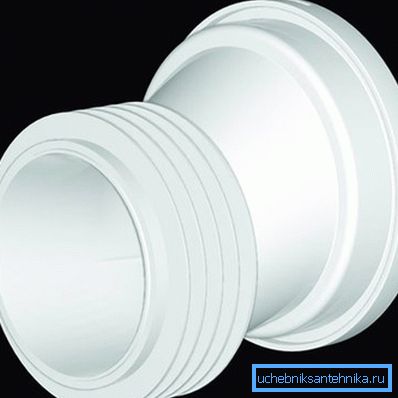
Cuff mounting
Install or replace parts
Now it's time to figure out how to install the cuff on the toilet. It is very important to know even if the construction work during the repair in your house was done by hired workers.
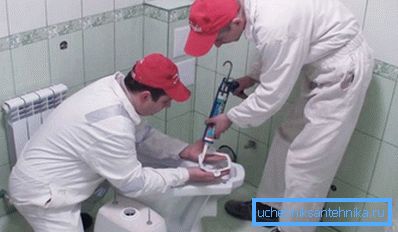
The fact is that sometimes this part gives a leak, because of which it is impossible to use the toilet. Consequently, you will need to urgently replace the cuff. The price of this service is quite high, so you can save a significant amount of money by completing the replacement yourself.
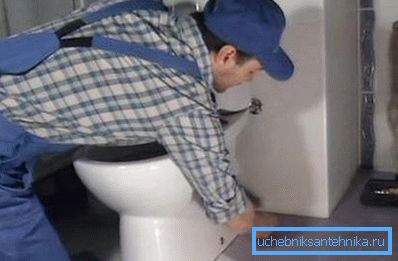
There is nothing difficult in this, it is enough to strictly adhere to the sequence of actions outlined below:
- You must thoroughly clean the toilet outlet from the remnants of the old cuff, sealant, debris, dust and dirt. At the same time, it is recommended to perform similar actions with the inlet of the sewer network.

Note! Cleaning should be done as thoroughly as possible. Garbage and dust can cause leaks in the future, which will force you to start work from scratch.
- To get the most tight connection, the pipe and the sewer inlet must be thoroughly dried.. Remains of moisture will not allow to apply sealant which, again, can lead to leaks.
- At the end of the preparatory operations, silicone sanitary sealant should be applied to the previously acquired cuff.. Although some experts are prepared to do without additional sealing, you should not neglect the use of silicone. Thus obtained connection will be as reliable as possible.
- First you need to coat the part that is put on the toilet. Then the cuff is mounted on the fitting of the sanitary device and is left alone until the silicone is completely cured.
- After this procedure is repeated, but with a hole in the sewer network.. With proper fit, all operations are performed without significant physical effort and any difficulty.
Tip! At the end of the installation of the cuff, it is advisable not to use the toilet for several hours, so that the silicone sealant grips well and provides the most tight joint.
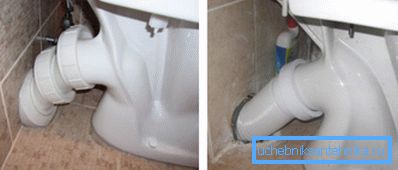
Emergency temporary leak fix
There are cases when the leak was formed suddenly and there is no time to buy and install the cuff.
In this case, there are two ways to deal with the problem:
- Use an elastic rubber bandage, which is sold in pharmacies. To do this, take a rubber band and wrap it around the toilet bowl, which is wearing a cuff.
It is better to carry out this operation together, since you will hardly be able to provide the necessary degree of tension yourself.
- Close the leak with a plastic bag tied with string. In this case, you need to take cellophane, wrap the leak and firmly secure with a thick thread. Several such layers can be made to ensure maximum tightness.

Note! The methods described above are a temporary solution to the problem. As soon as you have the opportunity, you should replace the damaged cuff with a new one.
Conclusion
Properly selected cuff, made of high-quality polymer or rubber, provides the most tight connection of the toilet bowl to the sewer network. However, to use the toilet was safe, you need to properly perform the installation of the sanitary device. For more on this, see the video in this article.